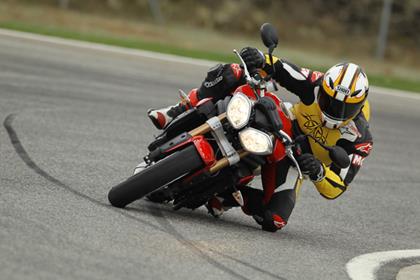2011 Speed Triple: Your questions answered
Simon Warburton, 45, is Product Manager for Triumph Motorcycles. Every new model idea, prototype testing report and final specification for all Triumph machines lands on his desk. For these reasons he is perfectly placed to answer MCN readers’ questions about the new Speed Triple.
Q: Why did you change the iconic headlights so drastically?
Joe Dillingham
SW: Because we needed to move on. Yes, the original lights are iconic, but now they are looking dated and we can’t stand still. For everyone that complains when we change something, there would be another 10 complain if we hadn’t. We’re really happy that so many people loved the old bike so much and that it’s a very important part of their lives – that’s great, but we do have to move on. You can’t stand still in the motorcycle industry.
Q: Why did you restyle it to look Japanese/Italian?
Pedro, Portugal
SW: Absolutely that was NOT the aim of the redesign. The aim was to make it look modern and to look like a significant step forward while retaining Speed Triple attributes like the twin headlights, twin high-level silencers, single-sided swingarm and twin spar over the engine frame. It remains an absolutely unique bike, but it is different to the old Speed Triple, no question. It had to be. The old bike looks like an old bike now, to be honest.
Q: Why have you only given it a 5bhp increase? Does Triumph feel it doesn’t need much more power?
Kris Hallam
SW: To a certain extent, you are right. The focus was on increasing torque, because this bike is not all about peak power – it’s about torque throughout the rev range. What people love about the Speed Triple is the fact you’ve got strong torque from just off idle all the way up to the top end, and what we’ve done is made that stronger because we’ve focused on improving mid to upper mid-range. That means the actual peak power increase is quite small. What is important is that further down the range you’ve something like 10bhp extra. If you look between 6000-8500rpm, the increase is more than five horsepower, but it’s not the peak horsepower figure.
Q: Has Triumph done anything to make the new Speed Triple cope better with the UK climate? Has the bike been designed for water to not get into places it shouldn’t and are the electrics well protected?
Kwacky
SW: No and yes. If all the above is based on the customer’s experience, then I’d say he’s had a bit of bad luck because it is not typical of people’s experience of the Speed Triple. We have IP [Ingress Protection] ratings on critical connectors, and better IP ratings than some manufacturers. More of our screws, bolts and nuts are also much more robust. We pay a lot of attention to corrosion resistance. Although it is true to say that we are developing new ones all the time. We constantly improve our bikes, even midway through production runs.
Q: Seat height appears to be the same as last year’s, but what about saddle width? It makes the bike a lot taller for us shorties…
Dameon White
SW: The seat is 5mm lower, but if you hop off one onto the other, it feels a lot lower. The whole bike is narrower around the outrigger area, so it is easier to get your feet on the floor. My legs are not particularly long and it feels more like 10-15mm lower to me. There is an accessory low seat that will be available in a couple of months to take it another 20mm lower.
Q: Why didn’t Triumph think of adding more extras as per Ducati, BMW and so on, in terms of electronics like traction control and variable power?
Jaques Livine, Paris
SW: To use such additions properly, you need to have ride-by-wire throttle, which we haven’t got yet. There is also the case that we didn’t feel the bike needed it, which is the same reason we didn’t fit a slipper clutch. We are developing ride-by-wire for the future, but to be honest we don’t think it’s really an option on this bike.
Q: Has your customer care improved?
Christoper Hardy
SW: You’ve obviously had some issues. Yes, it’s always improving. Everything we do, we are trying to improve.
Q: Has the steering lock (turning circle) improved?
Aashad, Spain
SW: It has improved slightly. We have increased the control of the lock stops. What we had before was quite a lot of variability, so some of the bikes were more restricted than they should have been because it was a cast surface coming up against a cast surface – now we have machined surfaces controlling the lock, so there’s a small improvement of only about 1°.
Q: The old model felt very coarse and crude in terms of suspension adjustment. Is the new Showa system an improvement?
Giles Newport
SW: Thorough development and testing will always bring improvement. We know it is. But you are better off asking MCN’s test rider to see if he agrees. [It is, by a considerable margin. It had to be, with the change in forward weight bias – T Franklin.]
Read more about the 2011 Triumph Speed Triple


